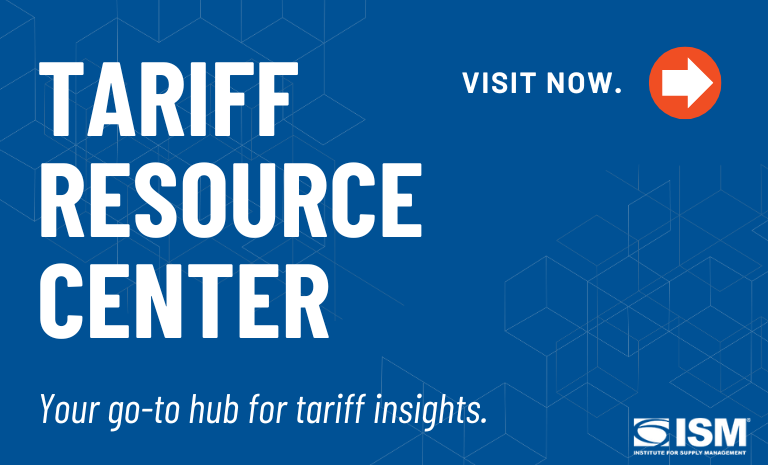ISM Supply Chain Planning Forecast: A Sharp Turn in Sentiment

In scanning the text of the ISM Supply Chain Planning Forecast released last week, one didn’t need a magnifying glass to find the buzzword regarding expectations in the manufacturing and services sectors for the rest of the year.
The descriptor of choice was “flat,” not only in forecasts for both sectors, but for the U.S. economy — a contrast from the largely optimistic expectations for 2025 reported by the same panels in December.
Tariffs and trade-policy uncertainties since the Trump administration took power in January have shrunk capital investment enthusiasm. Prices have continued to rise; revenues and employment are also projected to be sluggish.
The Forecast is based on responses from the Institute for Supply Management® Manufacturing and Services Business Survey panelists that help compile the monthly ISM® Report On Business®. Formerly known as the Semiannual Economic Forecast, it reports recent sector performance, as well as expectations for the rest of the year, from the purchasing and supply executives on the front lines of the economy.
The results are not out of line with recent editions of the Manufacturing and Services ISM® Report On Business®, and in fact affirm some of the red flags apparent in the April PMI® data. One of the biggest was the Manufacturing Production Index, which fell to 44 percent — a disturbing number, Timothy R. Fiore, CPSM, C.P.M., the outgoing Chair of the ISM Manufacturing Business Survey Committee, said then.
“We’re heading in the wrong direction,” Fiore said. “The (Production Index) number is a signal for revenue. When companies lose revenue, they release more workers, and on we go.”
That cycle was manifested in the Forecast, which projects a 0.1-percent manufacturing revenue increase for 2025, down from a 4.2-percent expectation in December. In services, revenue is expected to be flat after a 3.9-percent projected increase six months ago. After both sectors projected modest employment increases in December, manufacturing head counts are expected to be 0.1 percent lower, with a 1.6-percent drop in services.
Amid those dynamics — and especially trade turbulence — capital expenditure projections have taken a significant hit. Manufacturing panelists in December projected a 5.2-percent increase for this year, current expectations are for a 1.3-percent decreases. A projected increase of 5.1 percent in services six months ago is now an expected 3.3-percent decline.
“There was a lot of commentary regarding decision-making and planning difficulties around potential tariff impacts,” Steve Miller, CPSM, CSCP, Chair of the ISM Services Business Survey Committee, said after the April PMI® release. “After the additional inventory ordering (in recent months), there’s been a pause until people see how the tariffs actually shake out.
“You’re seeing that on the manufacturing side, and many companies in the services industry are holding off on making additional commitments while they while they work through their inventory and see how tariffs land.”
The operating rate — the share of a sector’s production or provision capacity that is being used — is 79.2 percent in manufacturing, down from 82.3 percent in December. In services, those numbers (current figures, not projections) are 86.5 percent and 87.4 percent, respectively. Productions capacity expectations for 2025 — an increase of 1.8 percent in manufacturing and a decrease of 1.1 percent in services — are lower than six months ago.
“We’ve gone into another liquidity year, rather than a productivity year,” Fiore told Manufacturing Dive, “all driven by tariffs.” (Fiore stepped down as Manufacturing Business Survey Committee Chair earlier this month; the Forecast was his last report. His successor is Susan Spence, MBA, effective with the release of the ISM® Report On Business® for May.)
The Forecast data was compiled before the U.S. and China agreed to a trade ceasefire last week, lowering many tariffs for at least 90 days. That’s a start, Comerica Bank economists Bill Adams and Waran Bhahirethan wrote in a note to investors and clients: “Public sentiment could refocus from tariffs to potential benefits from tax cuts and deregulation. That could fuel a recovery of businesses’ risk taking and hiring, and help consumer spending to stabilize.”
But Adams and Bhahirethan acknowledged those are ifs, and duties on many Chinese imports remain at an onerous 30 percent. The next ISM Supply Chain Planning Forecast, released in December, will indicate how many of those ifs became reality, and how much sentiment shifts.
Among other Forecast findings:
- Prices paid by manufacturing respondents’ companies elevated 4.7 percent through April, with a 7.5-percent expected increase for all of 2025. In services, the figures are 4.3 percent and 7.3 percent, respectively.
- In a special question, 35 percent of manufacturing panelists and 23 percent of those in services reported that their companies will pass all tariffs price increases to customers. Fifty-two percent and 28 percent, respectfully, expect to pass some increases and accept lower profits.
- A majority (60 percent) of services companies and 34 percent of manufacturing organizations are not looking into changing supply chain partners in the next six months as a response to trade uncertainties. Thirty-one percent of manufacturing panelists and 21 percent in services indicated their companies were not reshoring but looking for alternative sourcing in less tariff-impacted countries.

